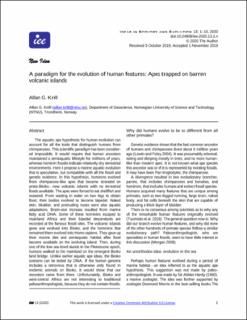| dc.contributor.author | Krill, Allan George | |
| dc.date.accessioned | 2022-05-09T13:36:29Z | |
| dc.date.available | 2022-05-09T13:36:29Z | |
| dc.date.created | 2020-08-26T11:34:43Z | |
| dc.date.issued | 2020 | |
| dc.identifier.citation | Ideas in Ecology and Evolution (IEE). 2020, 13 1-10. | en_US |
| dc.identifier.uri | https://hdl.handle.net/11250/2994843 | |
| dc.description.abstract | The aquatic ape hypothesis for human evolution can account for all the traits that distinguish humans from chimpanzees. This scientific paradigm has been considered impossible. It would require that human ancestors maintained a semiaquatic lifestyle for millions of years, whereas hominin fossils indicate relatively dry terrestrial environments. Here I propose a marine aquatic evolution that is speculative, but compatible with all the fossil and genetic evidence. In this hypothesis, hominins evolved from chimpanzee-like apes that became stranded on proto-Bioko — new volcanic islands with no terrestrial foods available. The apes were forced to eat shellfish and seaweed. From wading in water on two legs to obtain food, their bodies evolved to become bipedal. Naked skin, blubber, and protruding noses were also aquatic adaptations. Brain-size increase resulted from marine fatty acid DHA. Some of these hominins escaped to mainland Africa and their bipedal descendants are recorded at the famous fossil sites. The volcanic islands grew and evolved into Bioko, and the hominins that remained there evolved into Homo sapiens. They gave up their marine diet and semiaquatic habitat after food became available on the evolving island. Then, during one of the low sea-level stands in the Pleistocene epoch, humans walked to the mainland on the emergent Bioko land bridge. Unlike earlier aquatic ape ideas, the Bioko scenario can be tested by DNA. If the human genome includes a retrovirus that is otherwise only found in endemic animals on Bioko, it would show that our ancestors came from there. Unfortunately, Bioko and west-central Africa are not interesting to traditional paleoanthropologists, because they do not contain fossils. | en_US |
| dc.language.iso | eng | en_US |
| dc.publisher | IEE, Queen's University, Kingston, Ontario Canada | en_US |
| dc.rights | Navngivelse 4.0 Internasjonal | * |
| dc.rights.uri | http://creativecommons.org/licenses/by/4.0/deed.no | * |
| dc.title | A paradigm for the evolution of human features: Apes trapped on barren volcanic islands | en_US |
| dc.title.alternative | A paradigm for the evolution of human features: Apes trapped on barren volcanic islands | en_US |
| dc.type | Peer reviewed | en_US |
| dc.type | Journal article | en_US |
| dc.description.version | publishedVersion | en_US |
| dc.source.pagenumber | 1-10 | en_US |
| dc.source.volume | 13 | en_US |
| dc.source.journal | Ideas in Ecology and Evolution (IEE) | en_US |
| dc.identifier.doi | 10.24908/iee.2020.13.1.n | |
| dc.identifier.cristin | 1825229 | |
| cristin.ispublished | true | |
| cristin.fulltext | original | |
| cristin.qualitycode | 1 | |

